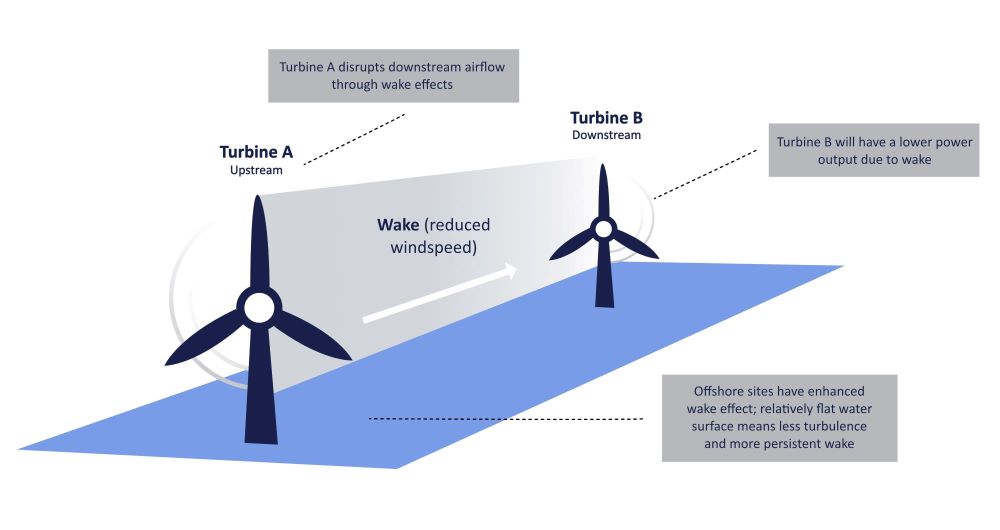Wake effects, which occur when wind turbines disrupt airflow to other turbines nearby, can impact the energy production of downwind projects. To date, there has been little discussion on these potential inter-project interactions and how to plan for them with the upcoming surge in offshore wind projects. This lack of coordination can have economic consequences— a case study involving two onshore wind farms in West Texas from 2009 to 2015 found that wake effects from the upwind farm caused $730,000 in lost sales annually or $2 million annually when lost revenue from the production tax credit was included for the downwind project. This economic impact does not include the over 100,000 tons of estimated CO2 savings lost due to the reduced generation.
Why this matters
The United States is set to substantially expand offshore wind development over the next decade. The Biden Administration is targeting 30 GW of offshore wind deployment by 2030, which is enough to power 10 million homes. The administration has also announced a Floating Offshore Wind Shot program with a goal of 15 GW of floating offshore wind capacity by 2035. This rapid expansion of offshore wind projects will greatly amplify the economic impact that wake effects could have within and between projects.
What are wake effects?
A wind turbine extracts kinetic energy from the air to produce power, resulting in a downstream region of reduced wind speeds and increased turbulence called a “wake,” just like the turbulent wake created by a passing boat. A second, identical turbine placed within this wake region, as illustrated in Figure 1, will have a lower power output than the upstream turbine.

Figure 1: Wake effect
Researchers and engineers have successfully worked to optimize the design of individual wind turbines. However, wake effects reduce the overall output of a wind farm and potentially any neighboring wind farms. This could particularly impact areas with a dense concentration of adjoining wind projects. This is also especially true for offshore farms, where there is lower surface roughness and therefore much less turbulence compared to land. Although these steady conditions are favorable for minimizing load fatigue (thus extending the lifetime of turbines), the lower turbulence slows wake recovery and produces longer wakes. To date, there has been little to no discussion about optimization of wind farms beyond a single project boundary.
How do offshore wind planning processes account for wake effects?
Currently, wind developers determining turbine spacing primarily consider factors such as land area and cable costs, as well as zoning codes and aesthetics. The end result is often a uniform grid layout—artificial designs that are not at all optimized for power production. The five New England offshore wind leaseholders, for example, proposed a 1 nautical mile spacing arrangement for their farms.
In general, intra-farm wake effects lead to a 10 to 20 percent reduction in the energy produced from utility-scale wind farms. Researchers have proposed many ideas to address this—for instance, spacing arrangements that maximize power production, a mixture of turbines of different heights, and modified yaw angles through wake steering (yaw is the orientation of the turbine rotor towards the wind). Adopting an integrated systems perspective and operating a wind farm collectively by varying yaw can increase its output. Researchers at MIT recently developed a model to predict the power-maximizing wake control strategy for a wind farm.
The issue of inter-farm impacts is further complicated by the lack of incentive for developers to protect another farm’s wind resource. There is no legal guidance on the issue of wake effects, which could become increasingly problematic as developers snap up preferred wind locations (for onshore and eventually offshore sites). The Minnesota PUC has begun to establish spacing mandates and include wake loss studies in permit applications. By considering these losses in the permitting process, commissions can protect valuable wind resources.
Planning ahead for offshore wind expansion
The expansion of offshore wind will require careful planning. Today’s U.S. electricity system emerged from a patchwork approach. With the transition to renewables, stakeholders have an opportunity to address anticipated issues in advance. Specifically, wake effects are predictable, and developers can design and operate farms to minimize these impacts. To make sure this happens, commissions and stakeholders should consider these effects when setting guidelines and evaluating plans for offshore wind. How well commissions and stakeholders approach this process will shape the success of the shift to a clean energy system that can heavily rely on offshore wind.
Synapse is constantly tracking new considerations in the offshore wind space, translating technical research to policy outcomes. We have worked on wind energy analysis across North America, and specifically on offshore wind issues in Delaware, Maryland, and across the Mid-Atlantic. Synapse is well-equipped to incorporate wake effects into our analysis and testimony to support a holistic planning approach.
Selma Sharaf
Research Associate, Synapse Energy